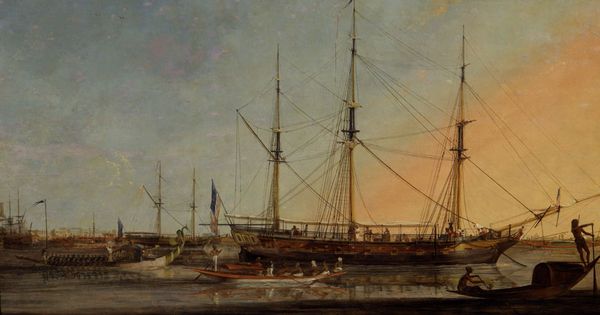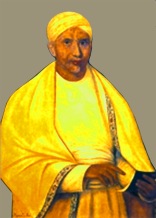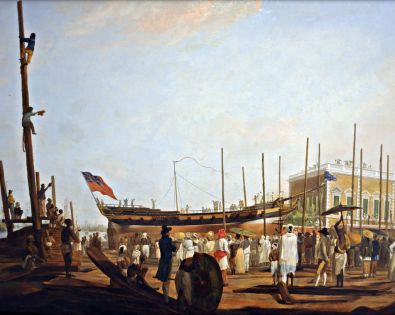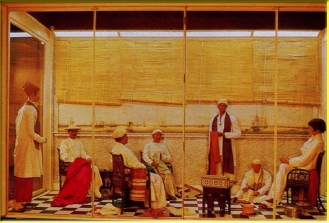
রামদুলাল দে, ১৭৫২-১৮২৫
Backdrop
Ramdulal Dey, the millionaire Bengal merchant of late 18th and early 19th centuries, was the foremost name in the chronicle of Indo-American maritime trade. Trading in Calcutta was one of the very important mercantile experiences of America during her early phase of modern globalization. They reached Calcutta in 1775, on the ship Hydra, jointly owned by the Americans and the English. It was a critical time for the newly independent Americans. Being cut off from the West Indies and deprived of their traditional market, they were on the look for a new opportunity for trading. In the context of Napoleonic wars, the opportunity came their way to replace Europe’s East India trade. The wars kept all British ships busy in territorial defense. The European colonial powers were in constant conflict around Indian and Atlantic oceans. America, being a neutral nation, held a strategic position to exploit seaborne trading across troubled seas.
American’s trade with British India began to grow extensively from 1790. In an average America sent 30 to 50 ships annually to Calcutta only. As it was estimated in 1806, within some years America had imported goods from Calcutta worth of at least three millions of dollars. ‘Calcutta was the most active Indian port for their commerce. Americans in India never established a commercial house as they did in China. Nor did they use the European agency houses. Instead they made use of the services of the banians, or the Indian brokers. With East India Company background, the banians at Calcutta were already reputed professionals. A small number of banians took advantages of the situation and became specialists in the American trade. Ramdulal Dey, Asutosh Dey and Promathanath Dey, Rajindra Datta, Kalidas Datta, Rajkrishna and Radhakrishana Mitra, Ramchandra Banarjee, Kalisankar and Durgaprasad Ghose were some of the early banians who carried on big business in Calcutta with the Americans. Among them Ramdulal Dey was the first and most famous banian connected with the American trade.
Early Life
Ramdulal Dey was also known as ‘Ramdulal Sarkar’, ‘Sarkar’ being a honorific title used in his family. Ramdulal also wore a compound surname ‘DeSarkar’ combining his hereditary title and the surname, comparable with the DeSarkars – common in some parts of eastern India. In intimate circles Ramdulal was better known by his sobriquet ‘Dulal’, ‘Doolal’ or ‘Dolloll’. In later years when he married his grandson off to a girl of higher caste, Ramdulal changed his family surname ‘Dey’ or its variant ‘De” into Brahmin sounding honorific ‘Deb’. (See Huttum /Kaliprasanna Singha)

Ramdulal Dey, alias Dulal Sarkar was the eldest son of Balaram Sarkar, a poor villager of Rekjani, a hamlet near Dumdum. His only occupation was to impart Bengali writing skill to the children of the peasants backed by his rudimentary knowledge of Bengali and the gifted skill in calligraphic art he had. During the Mahratta invasion of 1751-52, Balaram with his expectant wife fled from his ancestral home for good. On their way, Ramdulal was born and began his journey of life with empty hands. Balaram, before he died, could give him nothing, not even rudiments of his own vernacular to his child. Ramdulal had already lost his mother. It was his maternal grandfather, Ramsundar Biswas who took the orphan boy to Calcutta where he lived ‘upon the fruits of beggary’, and his wife used to husk rice for the market until she could secure a stable job of a cook in the house of a wealthy merchant at Hatkhola. She brought in her grandson, Dulal, to stay with her. The master of the house, Madanmohan Dutta, Dewan of Export Warehouses, ‘the rival in wealth of Rajah Navokrishna’, did not mind adding Ramdulal to the long list of his dependents. Here Ramdulal managed to receive his first lessons from the pundit engaged for the sons of his master. He had only to buy erasable palm leaves for mastering alphabets, and plantain leaves for copying texts. His will and energy made him soon an excellent penman and a fast accountant. He also picked up by then some broken English.
Madanmohan must have found in Ramdulal his qualities before offering him the job of Bill Sarkar on a salary of Rs 5/- a month. ‘Even out from this contemptible amount he contrived by rigid parsimony to save as much as a hundred rupees’, which he invested in a timber depot at Bagbazar with the purpose of helping his grandpa. Being much impressed with these admirable traits in the character of his young protégé, Madanmohan promoted Ramdulal to Ship Sarkar on pay of 10 rupees a month, ‘with lots of buxies, alternated of course by blows from ship captains, mates and crew.’ In all weathers, he was to go out into the mouth of the river at Diamond Harbour to superintendent the loading and unloading and discharge of cargo. After Khejuri Diamond Harbour was the place of anchorage for foreign vessels. In one of his trips he chanced to see a foundering vessel with full cargo close to the mouth of the Hooghly. Out of habit Ramdulal assess the nature of the wreck, cost of recovery and its worth.
After a short while, Ramdulal was sent to attend an auction at Tulloh and Company for certain items to buy. Sadly, all those items were sold out before Ramdulal stepped in. Right that moment, the auctioneer was lustily crying up a wreck – an item out of their next lot. The wreck was no other than the one Ramdulal had recently witnessed. He was tempted to bid with his master’s money. His bid, perhaps the only bid, was accepted. Ramdulal bought the wreck paying fourteen thousand rupees out of his master’s money. Before he left the place, an English gentleman rushed to him insisting on reselling the ship to him. After a long-drawn haggling the Englishman stumped out handsomely and got the sale transferred in his favour.

Back to his master, Ramdulal narrated the whole sequence before he humbly handed over to him the entire resale amount of nearly a lakh of rupees. His master, one of the progenitors of the Nimtala Duttas, had a princely soul. He blessed the boy – so unlike the world, so Roman in his honesty, and said, “Ramdoolal, the money is yours … you sowed the seed and you shall reap the harvest.” It was a treasure to a sarkar of 10 rupees a month. The windfall gift made up the working capital for his business venture that made him exceedingly rich and one of the richest in Calcutta during the lifetime of Madan Dutta. Ramdulal, however, never missed the occasion of receiving from his master his ten-rupee stipend and his blessings on pay days.
Banian of American Merchants

In no time Ramdulal made a fortune by careful investment and good luck. During growth of consignment trade and agency houses, he was attached to Fairly Fergusson & Company as their banian agent. At the same time he worked independently for other traders, equipped with his outstanding negotiation skills, market intelligence, and his all-round support service, including, establishing local market connections, organizing dadny merchants, market promotion, and financial assistance as well. He was on great demand. His cooperation was also sought by all British agency houses. Ramdulal partnered with the American traders rather than the European companies or English private merchants. Apart maritime trade, Ramdulal had active interest in stocks and shares, and real estates. The genius of Ramdulal, according to his biographer, could transform dross into gold. However, he owed his earthly prosperity mostly to the American merchants whom he served as their local agent, and also invested his own capital with them. American merchants used his credit in their coasting trade in the Bay of Bengal region and shared profit with Ramdulal.
From 1790 American trade with British India grew fast. Mostly the merchant houses of Boston, Salem, Beverly, Philadelphia, Providence, Marblehead, Yankee and New York sent their ships regularly to buy Bengal goods. Every house had its own banians stationed in Calcutta.

Annually 30 to 50 ships sailed to Calcutta, carrying cargo of dollars, iron, lead, brandy, Madeira and other wines, fish, spermaceti candles, mackerel, beef, beer, ice, variety of Europeans articles, tar, large and small spars. On their return the ships took varied types of Bengal goods, including tea, sugar, indigo, linseed, saltpeter, gunny bags, and most importantly, textiles. Many advertisements included lists of Indian textiles, such as bafta, gurrah, mamoody, and bandanna as well as names of the towns, like Alliabad, Dacca, Gaurypore, etc. where the cloths were made. ‘Every housewife in Salem knew the difference between gurrahs and mamoodies’. Of all the textiles exported to America, white cotton goods were by far the most common, although printed and dyed cottons, silk goods, especially handkerchiefs, mixed silk, cotton goods, and woollen shawls were also important. [See Bean] As recorded, the total American trade for the ten-year period beginning from 1795/6 exceeded by about one-fourth that carried on under the flags of all overseas partners including European nations. [See: Islam, ‘Yankee Maritime’]
The Americans carried on the bulk of their trade through the Indian brokers. It was not simply because of economic reasons they did it, but for the strategic advantage of having the highly competent and experienced Calcutta banians by their side.

The early Americans had treated the Indians with informality, humour and respect. Ramdulal Dey was the most prominent among them, and became a household name among the contemporary American business houses. He exhibited the greatest activity and fascination in alluring the trade of the America to the horbours of Bengal. The bulk of American business passed through Ramdulal’s hands. He came to be quoted as an authority in American commercial circles. So great was the confidence which his constituents in the new hemisphere reposed on his ability and his integrity, that for the first time in the history of Indian commerce, the merchants of America dispensed with European Agents in Bengal altogether. [See: Grish]
The extent of Ramdual Dey’s American connection may be guessed from the array of merchants of whom he was the sole agent in Bengal. The list found from the books of the period immediately following his death.
BOSTON
G.R. Minot, G. Warren, J.Young, J.S. Amory, T. Wigglesworth, J.I. Coleridge,
H. Irving, J.J. Bowditch, B.Rich and Son, E. Rhodes, F.W. Everitt, W. Godard,
Mackie and coleridge, H.Lee, O. Godwin, Theuring and Perkins.
NEW YORK
Messrs. Lennox & sons, G.S. Higginson, Messrs. C & D. Skinner, Messrs.
Singleton & Mezick, S. Austin Junior, W.C. Appleton, E.B. Crocker, E.
Davies, J.J. Dixwell, W.A. Brown, A. Baker junior, G. Brown. T.C. Bacon, M.
Curtis, Baring Brothers
PHILADELPHIA
Messrs. Grant & Stone.
SALEM
Pickering Dodge, W. London
NEWBERRY
The Hon’ble E.S. Rant, J.H. Telcombe.
MARVELHEAD.
J. Hooper
One of the American merchants fondly dedicated a vessel to ‘Ram Dolloll’ and named after him. The vessel sailed carrying Ramdulal’s consignment to Calcutta thrice during his lifetime. Among the ships he owned, Kamala, and Vimala were named after his two daughters, and the ship ‘David Clerk’ was named after one his American business partners and a personal friend.

American trade brought about ‘a new dimension to the cultural and commercial milieu of the city’. The American way of conducting the business helped in fostering some sort of cultural intercourse between Bengal and America. The Peabody Museum, Salem and the Essex institute in Massachusetts still hold nine portraits of banians in their collections are the potent survivors of such relationships. The portraits were commissioned by the banians for presentation to the Americans and business associates. The practice of commissioning and exchanging portraits is a tantalizing indication of cordial relationships as between equals. ‘In 1801 twenty-two American merchants in gratitude presented a life-sized oil on canvas, the first portrait of George Washington by William Winstanley . . . to their banian Ramdoolal Dey under whose guidance they had all prospered in the Bengal trade.’ [See: Bean]
Rags to Riches
The illustrious shipping magnet may serve as a striking example of ‘vertical mobility’ from poverty to wealth. Like two contemporaries, Akrur Dutta, and Krishnakanta Nandy (1720-95), Ramdulal rose to eminence from humble and obscure origins. Ramdulal Dey, the millionaire of the early 19th century, left estates worth of Rs 33,01,424 of which the Calcutta and suburban properties accounted for Rs 6,17,750, yielding an annual rent of Rs 25,314 (1825-26). By contrast the rural properties, all close to Calcutta, were worth only Rs 58,5000. He also left behind sundry promissory notes of the Hon’ble Company, shares in various insurance companies, sundry bonds mainly from Europeans, sundry bills including China supercargoes bill, notes from Rustomji Turner & Company, Davidson & Company, Palmer & Company, etc; ship David Clerk, shares in Sauger Island Society; and balances due from different companies. When one of the two sons of Ramdulal Dey died in 1854 his estates in Calcutta were worth Rs Rs 3,62,862 and the value of his zamindari properties was more than Rs 2,00,000. The proportion of zamindari properties to urban real estate demonstrated a substantial increase in one generation.
Ramdulal had a noble heart and a humanitarian mindset. His charity was proverbial. He liberally donated for the cause of education and social welfare unquestioningly. He was a benefactor to the greatest educational institution of early colonial Calcutta, the Hindu College. Ramdulal was ready to extend help to suffering humanity anywhere; He had sent donations to the flood and famine victims in Bakhargunge, Madras, and as far as in Ireland. Ramdulal established ‘Atithisala’ an asylum for the destitute in Belgachia. At Beneras, he erected 13 Shiva temples. For sanctification of the temples alone Ramdulal spent around Rs 2,22,000. Besides, public charity, Ramdulal in private helped the poor and needy in many ways. He kept aside Rs 70 a day for the relief of distressed persons. He employed three physicians for visiting the poor patients to administer medicines and provide medical comforts at his expense.
End of Journey
Ramdulal was a pious man. In spite of being fabulously wealthy he lived a simple life. The only regret he had, that his ambition for ‘Gostopati’ or the community leader of the Kayastha samaj remained unfulfilled. Ramdulal and his adversary, Raja Nabakrishna, were engaged in constant wrangling, backed up by their respective bands of supporters, বাবুর দল (Babur Dawl) and রাজার দল (Rajaar Dawl), where bards, jesters, and common citizens took part. The power struggle between the leaders also encouraged local talents to compose street music, street plays, cartoons etc. contributing to urban folk art and literature of lasting entertainment value and historical significance.
Ramdulal breathed his last on April 1, 1825. His two sons, Asutosh, and Pramathanath, famously known as ‘Chhatu Babu‘, and ‘Latu Babu‘, respectively, performed the ‘Sradh’ ceremony of their father with unprecedented grandeur spending nearly five lakhs of Rupees. Asutosh alias Chhatu Babu, himself a musician, was one of the leading connoisseurs and patrons of classical music. His nach ghar was famed for the performance of the celebrated musicians and dancers of the country. The family maintains the cultural tradition till now. Because of their social graces, Asutosh and Pramathanath, noted for their largesse, were called as the ‘Babus of Bengal’. The epithet highlights their refined taste, affluence and extravagance. The two brothers kept up the social and cultural status to a large extent, but not the level of prosperity Ramdulal had passed on to them. The vast wealth of Ramdulal Dey was rapidly dwindled down due to many a reason. With the failure of Union Bank in 1848, the condition of Banians declined in all respect, and Deys were no exception. Their unfortunate commercial speculations and land investments were among the other reasons, besides the extravagance of his successors who frenziedly pursued their fads and hobbies as well as their noble craze for the performing arts. The house of Ramdulal Dey and his sons, delinked with its eventful past, remains a glorious centre of patronage of classical music and stage art in Bengal.
SELECT REFERENCE LIST
Bean, Susan S,’Calcutta Banians for the American Trade: Portraits of Early
Nineteenth-Century Bengali Merchants in the Collections of the
Peabody Museum, Salem and Essex Institute’, Bombay 1990.
– ‘The American Market for Indian Textiles, 1785-1820: In the
Twilight of Traditional Cloth Manufacture’, Peabody Museum of
Salem, 1990.
Chakrabarti,Ranjan, ‘The Brown ships in the Indian Ocean: The American
Merchants and the Bengali Banians 1790-1880’, in Business history of
India, Kalpaz, Delhi, 2006.
Chakrabarti, Shubhra, ‘Collaboration and Resistance: Bengal Merchants and the
English East India Company, 1757-1833,’ Studies in History, 1994, vol. 10, No. 1.
Chaudhuri,Sushil, ‘European Companies and Pre-modern South Asian
Commercial System- A study of Bengal in the Eighteenth
Century’, Calcutta Historical Journal, XI: 1-2 (1986-87).
Ghose, Benoy, ‘Some Old Family Founders in 18th Century Calcutta’, Bengal
Past and Present, Vol. 79, No. 147, 1960
+Ghosh, Grish. C., Ramdulal Dey: The Bengali Millionaire, Calcutta, 1868.
Islam, Sirajul, ‘Americans in Calcutta Bazaars in the Early Nineteenth Century:
Images and Interpretations’, Journal of the Asiatic Society of
Bangladesh, Golden Jubilee Volume (1956-2005), 2005.
*Rahman, Murshida Bintey, Banians in the Bengal economy, 18th and 18th century. Dacca
University. 2013
Roy, Tirthankar. What is modern and Indian about the business history [ Book review]
LSEPS, 2015
Verny, Michael A, ‘An Eye for Prices, an Eye for Souls: Americans in the Indian Subcontinent, 1784-1838.’ Journal of the Early Republic 33: 3 (2013)
* Used extensively in this write up.
+ Courtesy : Dr Alok Ray for providing access and help


Dear sir I ,m independent scholer of history special east India company. I want book or list on East India company and trade activities from Calcutta or Bengal. Dhaynvad.
LikeLike
Hello Dear Reader,
I suggest you go to FIBiS site to find most comprehensive sources for your study. you may also find the texts I referenced on puronokolkata articles. Warm wishes
LikeLike
I was surfing the web for glimpses of Bengali businesses..To my surprise this came up first.Being a scion of Ramdulal I instantly read it up.I found certain elements which was unknown to me.People often come to us for information regarding Ramdulal and his two sons. This gave me certain information which I did not know.My sincere thanks to the author and request insertion of any new information found
LikeLike
Many thanks Kalyanbabu for your kind words. I would certainly update the post on Ramdulal whenever new data available for sharing. I do believe you can help me a lot by sharing your personal thoughts and family resources. I am available on phone # 9831240820. Warm regards and wishes
LikeLike
I agree with Kalyan Kumar Deb. Thank you!
LikeLike
Glad you like the post. Thanks and wishes
LikeLike
Hello, I cited some information from this article . This article proved to very helpful. I am working on a project on Mutty Lall Seal , a contemporary of Ramdulal Dey.
LikeLike
You are most welcome, Aditi. Will look forward to reading your article. Warm wishes.
LikeLike
Do let us know please….
LikeLike
You are welcome, Aditi! Look forward to see your work when finished. Wishes
LikeLike
Once Basumati Sahitya Mandir published a biography of Ramdulal Dey… Could you help his author?
LikeLike
Sorry, I could not find the name, as yet. I will keep trying
LikeLike
THIS ARTICLE IS BETTER THAN OTHERS IN AS MUCH AS WE,AS DESCENDANTS, KNOW
LikeLike
I thank you Kalyanbabu for your prized comments, delightful and inspiring. Hope you would agree with me that much remains, however, unexplored, and we need to discern the story of the development of his commercial success to know the genius in Ramdulal. Warm regards and wishes
LikeLike
Myself,not a historian but am often confronted with queries to which I don’t have answers only to dishearten them.So I am on the lookout for materials from all available sources to try not to discourage such persons P.S As far as my information is Ramdulal did become a Gostipati by giving Vidaayis to 1 lakh Brahmins.The ritual was called EKJAYEE. This ritual was also followed by his sons and his grandson Anath Nath Deb/Ounath Nath Deb as he used to write his name.I find that since then our ancestors are using Deb instead of Dey.I think that on three generation performing that ritual we have been bestowed this Title.I have heard that the last EKJAYEE was performed by him.Apart from financial involvement,in that time, it was not an easy task to find 1 lakh Brahmins at a time from Bengal alone.Early Brahmins came either from South India ort Uttar Pradesh
LikeLike
Thank you Kalyan Babu for sharing your thoughts with us. Most of us here are essentially students of history, and our investigations are inspired by our love for this city and its people, like Ramdulal Dey. It appears that you read Harisadhan Mukhopadhyay. His book, ‘Kolikata sekaler o ekaler’ is no doubt a gold mine. We only wish he had provided the sources of his information for necessary verification. I believe your interest may lead you further, and wish you very best.
LikeLike
Dear Sir — Iam an avid reader of ” Purano KOLKATA” posts — having been born
in a very old Early Calcatian family. Unfortunately since quite some time I am not receiveing regular inputs from your side. May you kindly send me your all recent posts — since above mentioned one. My ancestral house was in Bowbazar area i.e. near to Akrur Dutta Lane. ‘Got simply amazed on knowing so much “ENTREPRENEURIAL HISTORY”of Bengalee business class is strewn around the labyrinthine lanes of that area! I shall be immencely obliged if I may kindly be supplied with a list of publications in last two years — so that I may know clearly which “Posts” I didn’t receive & try to get them from you or other sources. With kind regards and very best wishes — yours sincerly — Dr.Nirmalyakumar Majumder.
________________________________
LikeLike
I thank you Dr Majumder for showing so much interest in my articles. Of late, I started feeling uneasy, as you do, for lagging behind after ‘Ramdula Dey’ was posted. Good thing that I have just finished some interesting 18th century works focused on puronokolkata, and hope to share my findings with you before long. As for the old posts you may start browsing from the most recent one and scrolling down to see the earlier topics published so far. If that is of no help, please drop a line here, or at asoknath.m@gmail.com for solution. Warm wishes
LikeLike
Another marvellous article on another remarkable Bengali from and era gone-by. Most beautifully capturing the significance of Ramdulal De’s meteoric rise and his amazing contribution to the social order of the day. The narration as engrossing as it is rich in anecdotal details of the times. Like the mention of, Ramdulal as a child, learning to write on erasable palm leaves and coping texts on plantain leaves… very interesting and very authentic.
I am indeed very grateful to you for having shared this article and the pictures.
LikeLike
Thank you Subhrendu for your kind words. Warm regards and wishes
LikeLike
I am an avid reader of anything written on the life of Ramdulal Sarkar. I was born and spent my childhood in Simla area. I keep Ramdulal in my heart in the same row of Swami Vivekananda, also of Simla, who through their works, regained the lost pride of India, forgotten during subjugation under exotic rulers for many centuries.
LikeLike
Thanks for sharing, Ajay. It is always a pleasure to know all our past glories not yet lost. Wishes
LikeLike